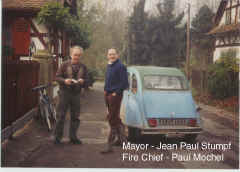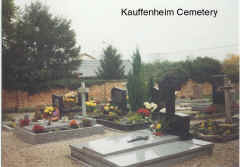|
In 1993 I was fortunate to be able to go to Germany. While I was there I crossed over the Rhine River at Rastatt in order
to visit the tiny village of Kauffenheim in France. It is situated just a few miles west of the Rhine river in a very pastoral
area. At the time there were just 203 people living there. There was one brick street just a few blocks long and another which
ran parallel to it, but hardly more than a one lane path. Connecting these two were a few side streets. The Wohlhuter home was on the main street and on the opposite side just a few doors down from the Evangelisch Kirche (Lutheran Church). I arrived there just before noon and drove up the one street and down the other. Seeing no one, I pulled into a space in front of the church. I had my lunch with me and decided that I would take time out to eat. (It was a good thing I had my lunch because I saw no place that I could have purchased anything.)
However, just as I had begun to eat, I looked into my rear view mirror down the Rue Eglise (Church Street) which was the one block long street which ran directly into the church and the place where I was parked. There I saw two men talking by the fence. One had a car, the other a bicycle. I decided that I should go at once to find out what I could from the only two people I had seen in town. Armed with my dictionary , pen and pad I got out of my car and walked down to where they stood. Neither spoke English, but with the help of my limited German and pointing to words in the German-English Dictionary I was able to learn that one was the Mayor, or Burghermeister, and the other the Fire Chief and we were standing in front of the Mayor's home.
When they learned the reason for my visit, they suggested that they walk with me to the Mayor's office in order to look at the old record books. On the way we passed the house where the Wohlhuter family had lived for many years . I was told that 1979 was the last year that any Wohlhuters had lived in the house. It was the typical half-framed house with the barn for the animals attached at the rear.
The Mayor's office was a small building at the end of the street with a sign "Mairie". (German was the language of the area, but because it is in France the name on the mayor's office was French.) The mayor unlocked the door and the three of us went in. There on the shelves were books with the records going back to the 1600's, yet on the desk was a computer, printer andopy machine. It seemed a bit strange to find such modern conveniences in a village where everything else appeared to be so primitive. They explained that it was nearly lunch time and so we did not have much time to spend. I found one thing that I had wanted to know and learned that I could probably find records about the Rinckels in nearby Forstfeld. So, I hurried with my research and we locked up and left.
 |
|
 |
I went back to my car and finished my lunch. I found the church was unlocked so I went in to look around. It was quite small and very pretty inside with beautiful wooden beams and a small but ornate altar. Then I went around the back to the cemetery. The graves were covered with slabs of marble, slightly raised above the ground and the tombstones for the most part were quite large. The ground around the graves was covered with stone and there was a brick wall surrounding the cemetery. All of the graves had beautiful flowers on them. I found just two graves with the name Wohlhuter and all the graves were fairly recent. I learned that in most of Europe after a certain number of years has past, the graves are pushed down and bodies are buried on top of the others in order to conserve space.
I reluctantly left this peaceful little community and headed for Forstfeld which was at the most three or four miles away. There I found the church was larger and had a secretary , who helped me find the birth record for Marie Catherine Rinckel, George's wife. Since I had several places to visit and not much time, I completed my task and drove back across the border into Germany wishing that I could have stayed longer.
|